
About UsThe Numismatic Bibliomania Society is a non-profit organization promoting numismatic literature. For more information please see our web site at coinbooks.org SubscriptionsThose wishing to become new E-Sylum subscribers (or wishing to Unsubscribe) can go to the following web page link MembershipThere is a membership application available on the web site Membership Application To join, print the application and return it with your check to the address printed on the application. Membership is only $15 to addresses in the U.S., $20 for First Class mail, and $25 elsewhere. For those without web access, write to: David M. Sundman, Secretary/TreasurerNumismatic Bibliomania
Society AsylumFor Asylum mailing address changes and other membership questions, contact David at this email address: dsundman@LittletonCoin.com SubmissionsTo submit items for publication in The E-Sylum, just Reply to this message, or write to the Editor at this address: whomren@coinlibrary.com
BUY THE BOOK BEFORE THE COINYou won't regret it! |
- WAYNE'S WORDS: THE E-SYLUM MAY 19, 2013
- RICHARD ROSSA 1943-2013
- SKLOW MAIL BID SALE NO. 19 CLOSES JUNE 1, 2013
- NEW PERIODICAL: O NVMISMATA (THE NVMISMATIST)
- BOOK REVIEW: IN GOLD WE TREASURE
- BOOK REVIEW: COINAGE AND CURRENCY IN EIGHTEENTH-CENTURY BRITAIN
- BOOK REVIEW: PICTURES FROM A DISTANT COUNTRY
- CALL FOR PAPERS: JOURNAL OF NUMISMATIC RESEARCH
- THE BREEN/BOWERS/RUDDY REVISION OF GILBERT'S HALF CENT BOOK
- COINS MINTED BY SCOVILL MANUFACTURING
- SCOVILL ORAL HISTORY PROJECT REPORT
- NOTES FROM E-SYLUM READERS: MAY 19, 2013
- BRIAN TIMMINS AND THE 2008 OBAMA SILVER ROUND
- THE GOLDBERG'S FITZGERALD LARGE CENT SALE CATALOG
- ANTIQUE GLASS GOBLET ENCAPSULATES AN 1832 DIME
- ANOTHER LIBERTY SEATED COIN GLASS SAUCE DISH
- WAYNE'S NUMISMATIC DIARY: MAY 19, 2013
- A FAKE STAR NOTE
- HOWARD DANIEL ON FAKES IN NUMISMATICS
- COLLECTIBLE COIN PROTECTION ACT RE-INTRODUCED
- THE 1981 U.S. COMMEMORATIVE COIN BILL
- INTERNATIONAL TRAVEL WITH PRECIOUS METALS
- AMAZON COINS
- SOTHEBY'S TO SELL BRITISH POSTAL MUSEUM DUPLICATES
- QUERY: STORIES OF MISATTRIBUTED COINS SOUGHT
- BALDWIN’S INAUGURAL MILITARY SALE
- VIKING COIN HOARD UNCOVERED IN DENMARK
- FEATURED WEB PAGE: COIN SPOONS
WAYNE'S WORDS: THE E-SYLUM MAY 19, 2013

We have no new subscribers this week. We have 1,650 email subscribers, plus 232 followers on Facebook. Welcome to our latest advertiser, Steve Hayden. Thank you for your support!
Before we start, here's a big early Happy Birthday wish from The E-Sylum to numismatic researcher and author Eric P. Newman. Born May 25, 1911, Saturday is his 102nd birthday!
On a sadder note, this week we open with word of the passing of token and medal dealer Richard Rossa. Next up is a reminder from David Sklow of his upcoming literature sale, a new online numismatic periodical, and three book reviews.
Other topics include the Breen/Bowers/Ruddy update of the Gilbery Half cent book, coins minted by Scovill Manufacturing, coins in antique glassware, coin spoons, fakes in numismatics, and a hoard of Viking coins.
To learn more about author grants from the Central States Numismatic Society, the Journal of Numismatic Research, the Brazilian Virtual Numismatic Association, engraver Brian Timmins, S.W. Chubbuck's Morse code token, the “Model Artists” peep show, the medal with a chicken helmet and the Contest of Fat Animals during the Sunday before Easter, read on. Have a great week, everyone!
Wayne Homren
Editor, The E-Sylum
RICHARD ROSSA 1943-2013
Alan V. Weinberg writes:
Tony Terranova called to inform me that Rich Rossa, partner with the late Steve Tanenbaum in the prominent exonumia firm Rossa & Tanenbaum died Saturday night in the hospital.
Rich had been involved in a serious traffic accident last January and had been in and out of the hospital with kidney dialysis and attendant infections partially resulting from the accident. His knowledge of numismatics and the esoteric ranges of the hobby was enormous. Between him and Tanenbaum there was scarcely a subject they weren't very knowledgeable about.
Rossa was semi-retired from the R & T firm perhaps a decade or so ago and could still be found searching the New York and Pennsylvania flea markets. Since Steve Tanenbaum's unfortunate and far premature death in Feb 2011, Rossa had been handling Steve's massive numismatic estate and, from all reports, was doing a creditable job.
Paul Bosco writes:
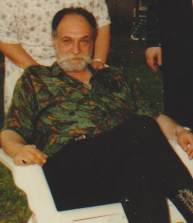 I had only just learned on Saturday that Rich had a car accident in January, breaking a hand and foot. He had been in the hospital several times since. Hospitals are dangerous places where germs are shared. Rich was about 70. I don't know the specific cause of death, but perhaps the disappointment of having to slow down was a contributing factor. He leaves his wife, Rita, his daughter Vicki, son-in-law Paul, and a 3-year-old grand-daughter.
I had only just learned on Saturday that Rich had a car accident in January, breaking a hand and foot. He had been in the hospital several times since. Hospitals are dangerous places where germs are shared. Rich was about 70. I don't know the specific cause of death, but perhaps the disappointment of having to slow down was a contributing factor. He leaves his wife, Rita, his daughter Vicki, son-in-law Paul, and a 3-year-old grand-daughter.
We have now lost both halves of Rossa and (Steve) Tanenbaum. Familiarly called "the RaTs" --they had a cartoon rat depicted on their business card-- they were possibly the most dynamic token-and-medal show dealers of all time. Steve was murdered in 2011, hit by a car.
Their success was based on the breadth of their combined knowledge, the size and scope of the inventory, some strategic "partnerships" (including close relationships with Joe Levine [PCAC], Dave Bowers and John Ford), their similar thinking and their opposite personalities. Also, HARD WORK, about which they NEVER complained, because they loved it, and their work fed their personal collections. A thousand times --maybe 2000-- Rich would drive to some antiques show, often with Steve, inevitably entering at the opening hour, 8am or earlier, after maybe 200 miles on the road.
I met Rich in 1975, when I worked at Schulman Coin and Mint. He was a bookkeeper of some sort, but was doing shows and I think he expected to go full-time shortly. A couple years later Tanenbaum left a very good position at IBM, I believe specifically to partner with Rich.
They were rather token-centric at first, but quick to make their mark in medals, as that part of the exonumia field grew in demand and prestige. Rich loved antiques, or perhaps more particularly collectibles, and such items also broadened their offerings.
"Rossa" sure sounds Italian, and Rich looked Italian, and he could and did cook huge Italian feasts around Christmas-time. I knew Tanenbaum, whose name means "Christmastree", was Jewish, but I always thought Rich was Italian. (He also had a temper from that part of the Mediterranean.) Turns out he descended from Hungarian Jews, and "Rosza" became Rossa at Ellis Island.
One of the great losses of my life was when Rich decided to slim down, and stopped doing his annual Brooklyn feasts.
Rich was not universally loved, and I say that while speaking as his friend. However, he could be as wise as he was shrewd, and capable of valuing you as a person, not just a business associate. He was often generous. As quick and fierce as his temper was, his rages were short-lived, and he was prone to self-awareness, and making amends.
I particularly remember Rich speaking at the memorial for Steve, attended by family, and by the few --yet surprisingly many-- colleagues who could come on negligible notice. Rich spoke first, and longest, It was plain that he knew Steve better than Steve's brothers, from Colorado and the Netherlands. Obviously conscious of an elevated role, he delivered an unvarnished tribute to the humanity of his "business spouse" -- the low comedy, the tedium and the triumphs-- that shared with all and imposed on no one. Rich had the personal generosity to step out of his own grief and speak, brilliantly, to those of us who needed to hear.
Those who knew him well know what a friend they have lost.
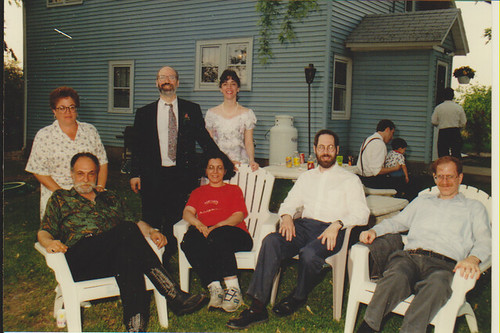
SKLOW MAIL BID SALE NO. 19 CLOSES JUNE 1, 2013
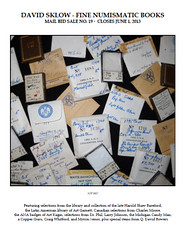 JUST TWO WEEKS LEFT TO SUBMIT YOUR BIDS
JUST TWO WEEKS LEFT TO SUBMIT YOUR BIDS
DAVID SKLOW - FINE NUMISMATIC BOOKS
MAIL BID SALE NO. 19 CLOSES JUNE 1, 2013
FEATURED ITEMS INCLUDE:
- Long run of Barney Bluestone Auction Catalogs
- Long run of M. H. Bolender Auction Catalogs
- Nice offering of hard bound Bowers & Merena Auction Catalogs
- Nice run of Thomas L. Elder Auction Catalogs
- Original Engraved Portraits of Washington, 1880, by Baker
- State Bank Notes of Michigan 1956, by Bowen including original correspondence
- Eckfeldt & Du Bois 1842 work, A Manual of Gold and Silver Coins of all Nations
- Two Stan V. Henkel Auction Catalogs, Collection of Engraved Portraits of Washington
- Nathaniel Paine’s 1866 Remarks on the Early Paper Currency of Massachusetts with 4 mounted photographic plates, Copy Number 16, ex: Q. David Bowers
- Selections from the library of the late Harold Shaw Bareford
- Deluxe interleaved edition of Browning’s Early Quarter Dollars work, by John J. Ford, ex: Homer Downing sale
- Plated Chapman Catalog of the Stickney sale, ex: Col. Green, C. E. Gilhousen, Homer Downing
- Plated Chapman Catalog of the Bement sale, ex: Homer Downing
- Plated Chapman Catalog of the Jackman sale, ex: Homer Downing
- Plated Chapman Catalog of the Gable sale, ex: Homer Downing
- Crosby’s Early Coins of America, 1878, ex: Homer Downing
- Plated Elder Catalog of the Mougey sale, ex: Col. Green, Homer Downing
- Many important auction sale catalogs concerning U. S. Large Cents with annotations by Harold Bareford
- Plated New York Coin & Stamp Co. Catalog of the Robert Coulton Davis sale
- Plated Chapman Catalog of the John Mills sale
- Newcomb U.S. Cents of 1801-1802-1803 with supplemental plates, autographed by Newcomb
- Clapp U.S. Cents of 1798-1799, ex: Homer Downing sale
- Crosby, Coinage of 1793, ex: Homer Downing sale
- Unbound limited numbered edition of John W. Adams U.S. Numismatic Literature Vol. II
- Four volumes of American State Papers
- ANA Badges of Art Kagin
- Canadian selections from the library of Charles Moore
- 1987 ANA Special edition Redbook, autographed by R. S. Yeoman & Chet Krause
- Long run of EAC Convention Auction Catalogs 1975-2000, many with deluxe photographic plates
- EAC Penny Wise 1967-1976
- Deluxe Full Leather # 9 of 12 Attribution Guide for U. S. Large Cents 1840-1857, by Grellman
- Deluxe Full Leather # 6 of 12 U. S. Large Cents 1793-1814, by Noyes
- Deluxe Full Leather # 6 of 12 U. S. Large Cents 1816-1839, by Noyes
- Deluxe Full Leather # 6 of 12 U. S. Large Cent – Plates Volume, by Noyes
- Deluxe hard bound The Story of the Starred Reverse Cent, by Pete Smith
- Colorado Territorial Scrip, by Mumey
- Complete set of Lester Merkin Auction Catalogs
- Four volumes of Numismata Graeca-Greek Coin Types, By Anson
- Traite des Monnaies Grecques et Romaines, by Ernest Babelon, Four Volumes
- A run of Sylloge Nummorum Graecorum: The Royal Danish National Museum, 27-33, 35, 37, 40, 42-43
- Selections from the Latin American working library of Art Garnett, many works autographed by the authors
- Over 100 nineteenth century American auction catalogs
- Bound set of Numismatic Literature from the American Numismatic Society
- Dekesel’s monumental works, Bibliography of Numismatic Books for the 16th & 17th centuries
- And much more!
Bidders may enter bids by mail, telephone, email or fax. The sale closes at 8pm mountain time, June 1, 2013, however, any bids left on our answering machines or sent by email or fax on or before midnight on closing day will be accepted.
Catalog is viewable on our website
Catalogs have been mailed to all individuals on our mailing list
Catalogs are available upon request at no charge.
DAVID SKLOW – FINE NUMISMATIC BOOKS
P.O. BOX 6321
COLORADO SPRINGS, CO 80934
TEL: (719) 302-5686
FAX: (719) 302-4933
numismaticbooks@aol.com
www.finenumismaticbooks.com
NEW PERIODICAL: O NVMISMATA (THE NVMISMATIST)

Rodrigo de Oliveira Leite writes:
The Brazilian Virtual Numismatic Association (AVBN in Portuguese) is a non-profit organization with the goal to promote numismatics in Brazil in a virtual way.
In May we published our first publication: the quarterly magazine O NVMISMATA (THE NVMISMATIST). The first edition has 39 pages of content, most in Portuguese but 1 article is in English.
Our membership fee is R$15.00 per year (US$10.00) and includes 4 digital editions of O NVMISMATA. Therefore, if you are interested you can check our website in www.avbn.net or e-mail me in vicepresidente@avbn.net. We are seeking for more English-speakers members for our Association and we want more articles in English in a near future.
BOOK REVIEW: IN GOLD WE TREASURE
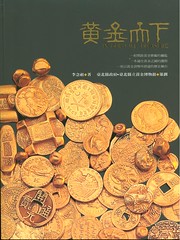 While I was in Taipei in February for a few days, I went into the 24/7 ES Lite Living bookstore. It was in a large building with thousands of new books mostly in English, but several other languages too. I found the hobby section and there were the usual Standard Catalogs of World Coins and World Paper Money, and other books in Chinese.
While I was in Taipei in February for a few days, I went into the 24/7 ES Lite Living bookstore. It was in a large building with thousands of new books mostly in English, but several other languages too. I found the hobby section and there were the usual Standard Catalogs of World Coins and World Paper Money, and other books in Chinese.
One of the Chinese language books also had a little English in it and it covered gold (and a little silver) coins of the world. I flipped through it and found a Southeast Asia chapter. I saw a few authentic coins but I also saw what I believe are fantasies and replicas that should be copper or silver but they were in gold.
The book's English title is In Gold We Treasure. I could not read any other information except the ISBN, which is 978-9860-14305-8 and there are 206 pages. I asked a Chinese friend there to translate the other information for me. The author is Nian Zu Lee, and the publisher is Red Ant Publishing, Taipei.
The first edition was published in 2008 and this second edition was published in 2010. It also won a National Publication Award! I am very sure the judges likely did not know that some of the pieces illustrated in it are replicas and fantasies.
The book has very high quality paper and very nice printing. It has an illustration of one Vietnamese gold wafer which is authentic. This wafer is rarely shown in any reference, so I bought the book. I have tried to find the book online using the ISBN, Title, author, publisher, etc. but I cannot find it. If anyone can find a contact about this book, please write a comment in The E-Sylum about it.
BOOK REVIEW: COINAGE AND CURRENCY IN EIGHTEENTH-CENTURY BRITAIN
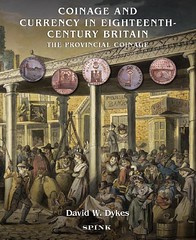 David W. Dykes, Coinage and Currency in Eighteenth-Century Britain. The Provincial Coinage. Spink, London, 2011. 383 pp. illus. throughout. Clothbound, thread stitching. 22 x 28.5 cm. ISBN 978-1-907427-16-9. £65.
David W. Dykes, Coinage and Currency in Eighteenth-Century Britain. The Provincial Coinage. Spink, London, 2011. 383 pp. illus. throughout. Clothbound, thread stitching. 22 x 28.5 cm. ISBN 978-1-907427-16-9. £65.
The European citizen takes it for granted that the government supplies him with enough small change. There may be something of a shortage thereof in exotic destinations like India – we reported on that rather frequently – but in this part of the world it seems hard to imagine getting no change at the baker’s.
We instantly recognize this as a very recent, very modern attitude when we look at the English tokens. At the end of the 18th century, Royal Mint was no longer able to meet the needs of non-face-value coins of a country that was in the process of becoming industrialized. The booming industry that paid the wages on a daily or weekly basis, and the retail trade with its demand of change coincided with the growing desire for advertisement and active collectors who bought these contemporary coins enthusiastically and hoarded them in their cabinets. Tons of private tokens were produced in only ten years, between 1787 and 1797, and not exclusively for actual use. The great number of quite well preserved specimens of this genre is no accident. Collectors’ editions came up as well as tokens for distributing political propaganda. Many a dealer sniffed a good stroke of business.
It was thanks to the incredibly detailed subjects on the tokens that collecting became such a profitable matter. They exhibit objects that are seldom encountered on official depictions. The inventory of a china shop, for example, or the machinery used by a candlemaker for manufacturing his candles, animals from a menagerie and, of course, minting presses. There is already a sufficient number of catalogs of such tokens available, but now David W. Dykes submits a bibliophilic opus with his monograph ‘Coinage and Currency in Eighteenth-Century Britain’ that illuminates the historical backdrop and introduces the manufacturers of these items.
The author presents a book which is a lot more than mere numismatics. Rather, the late 18th century society becomes alive. Already the companies’ histories of the most important token producers – Thomas William, Matthew Boulton, John Westwood, Skidmore & Son with all of their competitors – provide insight into the skills a successful entrepreneur had to possess in order to survive in an extremely competitive environment. By numerous quotations of original sources, Dyke tells their story in conjunction with information on the token issues they manufactured. The matter gets really exciting once he introduces individual commissioners and provides visual testimonies that served as model for the tokens.
Anyone able to use his imagination will enjoy this book. Auctioneers and coin dealers, menageries and glovemakers, state-of-the-art machines and stagecoaches – they all represent a new era and its people. Their way of thinking and the important role of political propaganda even back then can also be found in Dyke’s book. By means of the token it draws a pictorial broadsheet, as it were, that is a pleasure to read.
I would like to recommend this well-illustrated and carefully written book published by long-standing auction house Spink to anyone interested in the economic history of early modern times. Those who like everyday history will also enjoy this study. And it goes without saying that this opus is a must-have for every special collector of tokens.
To read the complete article, see: A numismatic glimpse inside English economic history (http://www.coinsweekly.com/en/News/4?&id=2004)
BOOK REVIEW: PICTURES FROM A DISTANT COUNTRY
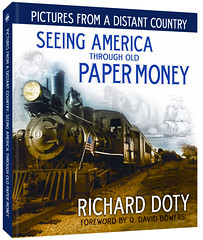 Pictures From a Distant Country: Seeing America Through Old Paper Money
Pictures From a Distant Country: Seeing America Through Old Paper Money
By: Richard Doty and Foreword By: Q. David Bowers,
Whitman Publishing, LLC, 2013,
Reviewed by: John and Nancy Wilson, NLG
Pictures From a Distant Country: Seeing America Through Old Paper Money was recently released by Whitman Publishing, LLC. Dr. Richard G. Doty, a Senior Curator of the National Numismatic Collection at the National Museum of American History of the Smithsonian Institution, was the author of this hardcover book. The reference has 296 pages and many color illustrations. The book was featured (almost a half-page) in the Review section of the April 13 - 14, 2013 edition of The Wall Street Journal. We cannot ever recall another numismatic reference receiving this kind of publicity from a non-numismatic media newspaper.
Dr. Doty takes you on an unforgettable journey of the story of the growth of America through the obsolete bank note vignettes or portraits that are depicted on them. With the Smithsonian collection, American Bank Note Co. archives and other printers, the author uses these tens of thousands of obsolete banknotes to tell his story of the growth of this magnificent country we all call America. Using the alphabet letters ABC, we find this reference - Artistic, Brilliant and Creative.
The Foreword by Q. David Bowers sums the book up with this quote, “Far from being just a “picture book,” the text guides the reader through the development of bank-note engraving, advances in artistry, selection of subjects, and the circumstances of issue.” By working for the American Numismatic Society in New York and then the Smithsonian Institution in Washington, Dr. Doty has examined 25,000 obsolete notes over the years. He soon became interested in the beauty of the notes and the interesting scenes they depicted. The book is his personal look at our past, using a medium which has been underutilized by historians and numismatists alike. The book doesn’t offer values, methods of conservation, or rarity.
With no specie available for early settlers in America right up to the start of the War Between the States, the author tells the story of the growth of America using illustrations that appeared on bank notes.
Chapter 1. Constructing a National Identity. Bankers used the different vignettes and portraits on notes, such as gold and silver coins, which helped persuade the public that a bank was strong. Some of the earliest symbols to appear on America’s money were the national mascot, the eagle, liberty or justice, vignettes of a Goddess, shields, flags, ships, battle scenes, early President’s and famous personalities of the time.
Chapter 2. The People in the Way. The author explains the many transformations that were taking place in early America during this early period. There were three groups who frequently appeared on our early currency: Native Americans, African-Americans, and women.
Chapter 3. The People in the Middle. The people in the middle were the African-Americans. Dr. Doty points out that only one image of an African-American was on a note prior to 1850. In the 1850s their images started to appear.
Chapter 4. Temptress, Saint, and Helpmeet: Woman’s Identity. In the 1820s women were portrayed in allegorical terms with a provocative or even erotic appearance. Later women were portrayed with a more sensitive quality. By the 1850s “real” women began to appear. Dr Doty has vignettes illustrating these periods.
Chapter 5. Childhood and Family. The portrayal of actual, living children, but in a romantic fashion, adopted from contemporary paintings which had found favor with the public was shown on many bank notes. Children are shown doing family chores and helping their mothers. In short real children engaged in real activities.
Chapter 6. Making a Living. One thing that nearly all citizens were seen to have in common was an engagement in meaningful, productive activity. There were four basic categories they were engaged in: working the land, working in mills and mines, working in trades and professions, and the final category is the depiction of pride in their work. Scenes of plowing and raising cattle abound. Factory work and the trades were covered extensively.
Chapter 7. Whimsy. “From the sublime to the ridiculous,” are the illustrations that will be found in this chapter. These vignettes did not seem to have any meaningful subject matter or meaning. The author goes on to say, “American private currency were those of instruction, celebration, and inspiration, but another was entertainment.” You will find illustrations in the chapter as the author says are, “too cute for words – the engraver’s equivalent of bad yard art.” The banks and businesses during this early part of America evidently enjoyed their power to place interesting vignettes and portraits on their notes, as you will see depicted in this chapter. The author’s use of “Whimsy,” seems to fit perfectly for this chapter.
Chapter 8. “You Can Trust Me”: Images of Worth. The Revolutionary War and Jacksonian Hard Times of the middle 1830s saw most paper money become worthless. This chapter describes the measures taken by the banks and businesses to place vignettes and portraits on notes that made the issues appear more credible with vignettes stressing fiscal trustworthiness and that this was an honest bank, a legitimate bank, run by people upon whom you could depend. The dog vignette or portrait came first, then large bank buildings, vignettes of coins, and other things of this nature. An interesting chapter that also has information regarding the modern credit card and 19th century private American currency security measures.
Chapter 9. Progress. The 20th century was the Age of the Automobile, the 19th century, the Age of the Train. The author says the train gave the population freedom of choice and movement.
Chapter 10. An Age Now Ending. The new industrialism, new ways of working the land, new peoples on our doorstep poised to enter and the transitions from the old, like horses, to the new, trains and autos. The author also talks about a few engravers and their “occasional reflection on the money they created and circulated.”
Epilogue: And Then What Happened? America’s paper money chronicled the march toward disunion. During the war years the increased need for private paper money on local, state, and national levels was evident. Unlike during the 1770s and 1780s when the inadequacy of public currency inspired private currency during the 1860s, the inadequacy of private currency led to the reintroduction of public currency and the demise of private currency forever.
We like Dr. Doty’s comments on how, “Intaglio work was safest, but all the intaglio printers were in enemy territory.” He further talks about what banks and businesses did to produce their money along with his thoughts on the printing companies and engravers of the time. You will find illustrations from Northern to Southern currency, including CSA issues; along a $10 Demand Note of 1861 and some early National Bank Notes. You will find many great stories in this chapter on how our money was produced and used in one of the most challenging times in America.
Appendix: Full-Size Bank-Note Images. All 344 notes that were discussed in this book are listed herein and shown in full, except forty which were used in the chapters. We think that the readers of this book will enjoy looking at the various vignettes and portraits that were used in the chapters, and then looking at the full size note reproduced here. Some of the notes are common and many are rare.
About the Author / Acknowledgments. The biography of Dr. Richard G. Doty will show the reader a short sketch of this famous numismatist. His Acknowledgments thank several people and in particular Cynthia Roden, who skillfully edited the book. He commented, “So this is Cindi’s book.”
Index to Bank-Note Issuers, by State. This is a full index of the bank notes in this book, organized by state and then by city.
We enjoyed reading this reference and think Dr. Richard Doty did a wonderful job of telling us a story about the growth of America through the depiction of vignettes and portraits on obsolete notes. In a very innovative way, you will learn just how life was back in the early to middle 1800s. When the Wall street Journal reviews your book, you know that non-numismatists from this paper thought this story on, Seeing America Through Old Paper Money, would be of interest to their readers. We feel that any collector, dealer, researcher, historian or library should have a copy of this book. You can purchase this reference from Whitman Publishing, LLC for $24.95, with ground shipping at $6.20. They can be reached at: Whitman Publishing, LLC, Main Office, 3103 Clairmont Road, Suite B, Atlanta, GA 30329 or call (800) 546-2995 or at the Whitman web site, www.whitmanbooks.com
THE BOOK BAZARRE
CALL FOR PAPERS: JOURNAL OF NUMISMATIC RESEARCH
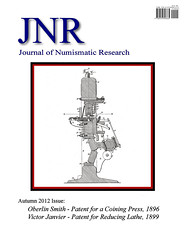 The Journal of Numismatic Research (JNR) is a publication dedicated to the advancement of knowledge in United States and Colonial era coinage including processes, operations, equipment, varieties, personnel and economic factors. Each issue is devoted to a theme and might contain several articles. JNR uses ISBN numbers for each issue so that they may be conveniently retrieved from archives in the future.
The Journal of Numismatic Research (JNR) is a publication dedicated to the advancement of knowledge in United States and Colonial era coinage including processes, operations, equipment, varieties, personnel and economic factors. Each issue is devoted to a theme and might contain several articles. JNR uses ISBN numbers for each issue so that they may be conveniently retrieved from archives in the future.
I am looking for articles for future issues. The basic criteria are: originality of research, critical analysis, meaningful conclusions, and attentive documentation. Articles may be of any length and all will be reviewed and edited for accuracy before publication. A modest remuneration is available to successful authors.
There are no deadlines for authors and work will be presented in the best manner possible consistent with accuracy.
Contact: Roger Burdette at accurateye@aol.com.
THE BREEN/BOWERS/RUDDY REVISION OF GILBERT'S HALF CENT BOOK
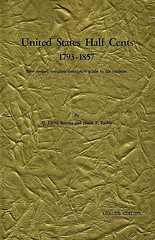 Quick quiz: Who has written more books about U.S. numismatics than any other currently living author?
Quick quiz: Who has written more books about U.S. numismatics than any other currently living author?
Answer: My good friend and fellow Coin World columnist, Q. David Bowers.
If you resolved to read all of his books, and budgeted a week for each one, a year from now, you’d still be happily reading!
As a historian, scholar and storyteller, he is peerless. But few remember that he did not actually write the very first coin book published under his name. This peculiar story begins in the 1950s, when half cent collectors faced two big problems.
The first problem was that the standard reference book for the series, The United States Half Cents, by Ebenezer Gilbert, was very rare.
The second was that even if you found a copy, it was outdated and full of errors.
Walter Breen, a brilliant, if troubled, young numismatist, started revising the Gilbert book in 1952, correcting its errors and recording newly discovered varieties. By the early 1960s, Breen finished, but, according to David Fanning, writing in The E-Sylum for June 29, 2003, Breen could not find a publisher and his current employer frowned on him publishing the book under his own name.
Breen offered Dave Bowers and Jim Ruddy, the principals of the Empire Coin Co., an unusual deal: If they would edit and publish his manuscript, they could take credit as authors.
They accepted, and the result, in 1962, was United States Half Cents, 1793-1857: New Revised Complete Descriptive Guide to the Series, a basic update of Gilbert.
Empire wrapped the 2,000 copies of the booklet in covers of a textured gold material, creating a “Deluxe Edition” personally signed and numbered by Bowers and Ruddy. (In fact, no “regular” edition existed; the Deluxe Edition is the only edition.)
To read the complete article, see: Gold cover(-up) (www.coinworld.com/articles/viewarticle/gold-cover-up)
To read the earlier E-Sylum article, see: BREEN HALF CENT MANUSCRIPT (www.coinbooks.org/esylum_v06n26a15.html)
COINS MINTED BY SCOVILL MANUFACTURING
Regarding Scoville Manufacturing, last week's article mentioned "22 different coins for 10 different countries" were made at the "Waterbury Mint". I don't think I have seen that list. Can someone tell me which coins were made by Scoville? A quick search on Google allowed me to compile this list:
Colombia
- 2-1/2 centavos 1881 & 1900 & 1902;
- 5 centavos 1886 (3 var.) 1888 & 1902
Dominican Republic
- 1 centavo 1877
- 2-1/2 centavos 1877
- 5 centavos 1877
Haiti
- 5 centavos 1904 (two designs); 1905
- 10c 1906
- 20c 1907
- 50c 1907 & 1908
Nicaragua
- 5 centavos 1898
- 5 centavos 1899 (different type than 1898)
Peru
- 2 centavos 1895
That should be 21 coins from 5 countries. I saw a rumor that Scoville may have made one or more coins for Chile in 1851, but have not confirmed this. What are the others?
- 1876 Venezuela 1 Centavo (blanks only, coins struck by U.S. Mint, Philadelphia) . . . . . . . . . . . . . . . . . . . . . . . . KM 25
- 1876 Venezuela 2½ Centavos (blanks only, coins struck by U.S. Mint, Philadelphia) . . . . . . . . . . . . . . . . . . . . . . . .KM 26
- 1877 Dominican Republic 1 Centavo . . . . . . . . . . . . . . . . . . . KM 3
- 1877 Dominican Republic 2½ Centavos . . . . . . . . . . . . . . . . . KM 4
- 1877 Dominican Republic 5 Centavos . . . . . . . . . . . . . . . . . . KM 5
- 1878 Netherlands . . . . . . . . . . . . . . . . . . . . . . . . . . . . . . . . . . . KM ?
- 1881 Colombia 2½ Centavos . . . . . . . . . . . . . . . . . . . . . . . KM 179
- 1886 Colombia 5 Centavos . . . . . . . . . . . . . . . . . . . . . . . . . KM 183
- 1888 Colombia 5 Centavos . . . . . . . . . . . . . . . . . . . . . . . . . KM 174
- 1891 Bolivia 50 Centavos . . . . . . . . . . . . . . . . . . . . . . . . . . KM 161
- 1891 Germany 1 Pfenning . . . . . . . . . . . . . . . . . . . . . . . . . . KM 10
- 1891 Germany 5 Pfenning . . . . . . . . . . . . . . . . . . . . . . . . . . KM 11
- 1895 Peru 2 Centavos . . . . . . . . . . . . . . . . . . . . . . . . . . . . . KM 188
- 1898 Nicaragua 5 Centavos . . . . . . . . . . . . . . . . . . . . . . . . . . KM 8
- 1899 Nicaragua 5 Centavos . . . . . . . . . . . . . . . . . . . . . . . . . . KM 8
- 1902 Colombia 2½ Centavos . . . . . . . . . . . . . . . . . . . . . . . KM 190
- 1902 Colombia 5 Centavos . . . . . . . . . . . . . . . . . . . . . . . . . KM 183
- 1904 China . . . . . . . . . . . . . . . . . . . . . . . . . . . . . . . . . . . . . . . . KM ?
- 1904-05 Haiti 5 Centimes . . . . . . . . . . . . . . . . . . . . . . . . . . KM 53
- 1905 India . . . . . . . . . . . . . . . . . . . . . . . . . . . . . . . . . . . . . . . . KM ?
- 1905 Mexico . . . . . . . . . . . . . . . . . . . . . . . . . . . . . . . . . . . . . . .KM ?
- 1906 Haiti 10 Centimes . . . . . . . . . . . . . . . . . . . . . . . . . . . . KM 54
- 1907 Haiti 20 Centimes . . . . . . . . . . . . . . . . . . . . . . . . . . . . KM 55
- 1907-08 Haiti 50 Centimes . . . . . . . . . . . . . . . . . . . . . . . . . KM 56
- Date? China . . . . . . . . . . . . . . . . . . . . . . . . . . . . . . . . . . . . . . KM ?
Dick adds:
I am uncertain about the coins for China as the records themselves were indistinct. They do mention a China coin in 1904, but a second reference may have been to that first, or a subsequent issue. Can anyone identify this Chinese coin? Also coins of Netherlands in 1878, and India and Mexico in 1905?
To read the earlier E-Sylum article, see: SCOVILL SUBJECT OF MUSEUM ORAL HISTORY PROJECT (www.coinbooks.org/esylum_v16n19a11.html)
On the topic of Scovill's tokens, Alan V. Weinberg writes:
I have read several times that Dr. George Fuld travelled to Waterbury CT in the 1950's and acquired a large number of Scovill's reference collection including thousands of rare Civil War tokens (and other Scovill tokens) in gem mint state. This accounts today for the profuse availability of Gem Unc regular and off-metal CWT's in numismatic "circulation" as well as other 19th century diesinker creations in superb mint state .
Perhaps George can provide The E-Sylum with a narrative account of that trip. If not, the late Steve Tanenbaum could have and perhaps Dave Bowers, a longtime friend of George Fuld and who is currently writing the new CWT "bible", can fill us in.
The topic has come up before. In the May 28, 2006 issue George Fuld wrote: "
"Since we discussed Scovill at some length in The E-Sylum, I thought I should mention that my father wrote up the story in 1968, which is being reprinted in the current Civil War Token Society Journal, Volume 40, Nos. 1, 2 and 3. My dad's memory was more up to date than my 50 year old recollections."
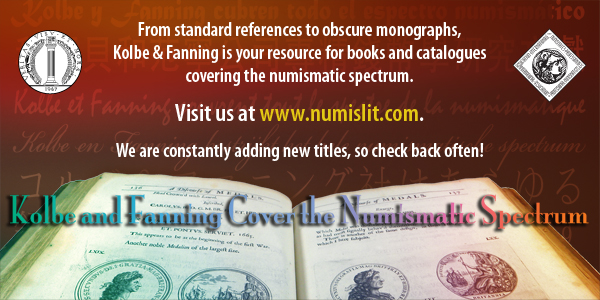
SCOVILL ORAL HISTORY PROJECT REPORT

For years I read the obituaries in the Waterbury newspaper occasionally seeing reference to their being a former Scovill employee. Wouldn't it have been useful to have interviewed that person before they died I thought.
Then in February this year I received an email from a lady in Georgia who said she was Scovill's archivist. She found one of the articles in The E-Sylum that I had written about Scovill and contacted Wayne Homren (he forwarded her initial email). Her email astounded me.
I had thought Scovill was completely out of business. But one small division which made zippers and fasteners had moved to Georgia in 1955. It has prospered (even after selling the zipper business) while all other divisions were acquired by giant corporations and closed down for the most part.
Emails and phone conversations with Cathy Sigmon blossomed. I mentioned interviewing old Scovill employees. She liked the idea, so I developed a plan to conduct several days of interviews at a museum in Waterbury. That museum would receive the taped interviews as a rare oral history resource for their archives, as would her archives.
Cathy obtained permission from the president of Scovill, Craig Stoudt, to sponsor the project. I presented the concept to Robert Burns, the director of the Mattatuck Museum in Waterbury. We received approval at every turn.
The week in May we chose occurred last week. We received publicity for our project in the local newspaper along with three newspaper ads announcing the event. These invited local citizens to come to the museum to be interviewed. We filled every time slot, an hour apart for 2 1/2 days, with two occasions when we conducted interviews in separate rooms at the same time.
We did not ask for donations. But we did ask for interviewees to bring some item about Scovill to help recall their memories. To our surprise many wanted to donate these items. They had been thinking of doing this for years many stated. This presented the opportunity.
I established the priority beforehand. The Mattatuck Museum had first choice of any donated item. What they did not want would go to Cathy's archives in Georgia. To our surprise we received: three paintings, one bound set of six Scovill Bulletins, the company magazine, numerous company pamphlets, sales literature, lots of photographs and correspondence (and two minor products).
It wasn't until the program at the end of the three days that three speakers give their recollections of Scovill that one gentleman pulled out a bag of Scovill mementoes he had saved. The last thing he showed me were the only numismatic items of the week -- two transportation tokens struck by Scovill.
But the experience of learning so much about the company I didn't know, adding to two archive collections, and recording some first-hand recollections for future researchers, was of spectacular value. I would do it again.
To read the earlier E-Sylum article, see: SCOVILL SUBJECT OF MUSEUM ORAL HISTORY PROJECT (www.coinbooks.org/esylum_v16n19a11.html)
NOTES FROM E-SYLUM READERS: MAY 19, 2013
On the E-Sylum's Scope
Chuck Heck writes:
What I like most about The E-Sylum is the scope. So many different areas are covered --- Ancient, Foreign, US. Coins, medals, paper money, books, and books about books; stories about collectors and their collections -- and everything is just so interesting.
My hobby is limited to U.S. Large Cents --- and just the year of 1794 because it has 69 distinct varieties. But I always look forward to your outstanding e-mail.
Central States Author Grant Expanded
Bruce Perdue writes:
The Board of Governors for Central States during the Spring board meeting voted to increase the Author Grants program to $40,000 for the upcoming Fiscal Year. The maximum per author is still $5,000, but we can now support more research efforts. The program information is available at: www.centralstates.info/bookgrants.html
Morse Code on S.W. Chubbuck Tokens
Mike Greenspan of
Houston, Texas writes:
After reading last week's E-Sylum about Morse Code on coins, I thought someone might have mentioned the attractive series of Merchant Tokens issued by S.W. Chubbuck, of Utica, NY, and catalogued by Russ Rulau as NY1055 through NY1063. Not only was Chubbuck a silversmith, he manufactured and dealt in Telegraph equipment, hence the advertisement on these tokens, including Morse Code. At one time, I owned his tokens in copper, brass, and white metal, but never found NY1060, the one issued in silver.

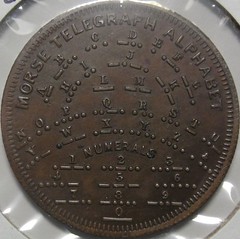
To read the earlier E-Sylum article, see: MORSE CODE ON MONEY (www.coinbooks.org/esylum_v16n19a18.html)
Movie Review: Who's Minding the Mint?
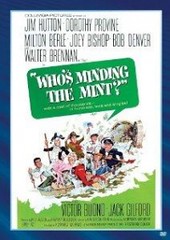 Tom DeLorey writes:
Tom DeLorey writes:
I do remember seeing "Who's Minding the Mint" when it first came out as a made-for-TV movie. Naturally I was appalled, even at my tender age, at the blunders in the movie, including the use of "Mint" rather than "Bureau of Engraving and Printing" just because Mint was alliterative. It was dumb then, and it is dumb now. But that's Hollywood!
Joe Boling adds:
Fred Reed has two photos and some text about "Who's Minding the Mint" in his book, Show Me the Money!
To read the earlier E-Sylum article, see: MOVIE REVIEW: WHO’S MINDING THE MINT? (www.coinbooks.org/esylum_v16n19a16.html)
More Robots in Numismatics
George Cuhaj submitted these items in response to my question about robots in numismatics. Thanks! He writes:
The Canadian space arm thingie has been on two Canadian coins also, both with a holographic applique. KM#668, silver 30 Dollars, 2006. Same design in gold, 300 dollars, KM 678.
Austria had done a great series of technology on their bi-metallic 25 euro coins. Their 2011 features the Mars rover.
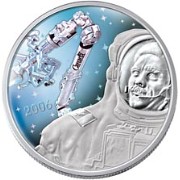
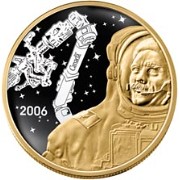
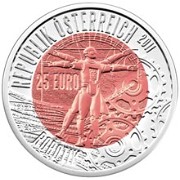
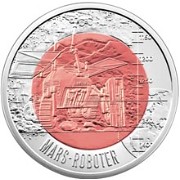
Austria 25 Euro commemorative in Niobium center in .900 silver
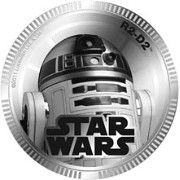
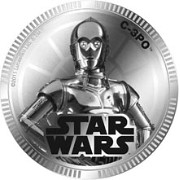
Star Wars: R2-D2, C3PO, courtesy of Niue/New Zealand Mint.
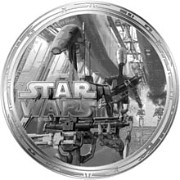
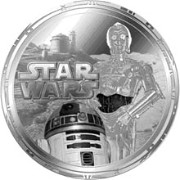
Star Wars: battle droid, courtesy of Niue/New Zealand Mint.
To read the earlier E-Sylum article, see: ROBOTS IN NUMISMATICS (www.coinbooks.org/esylum_v16n19a23.html)
Indian Cricket Star Featured on Gold Coin
Philip Mernick forwarded this article about a gold coin picturing an Indian cricket star. While the coin itself is only 10 grams, this publicity image makes the coin look huge.
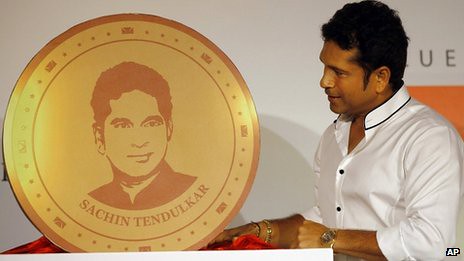
Philip writes:
How heavy if actual size?
To read the complete article, see: Sachin Tendulkar unveils gold coin engraved with his face (www.bbc.co.uk/news/world-asia-india-22520565)
The Roentgens' Berlin Secretary Desk
Gene Brandenburg forwarded a link to a great video of an absolutely amazing desk.
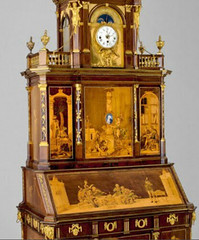 One of the finest achievements of European furniture making, this cabinet is the most important product from Abraham (1711--1793) and David Roentgen's (1743--1807) workshop. A writing cabinet crowned with a chiming clock, it features finely designed marquetry panels and elaborate mechanisms that allow for doors and drawers to be opened automatically at the touch of a button. Owned by King Frederick William II, the Berlin cabinet is uniquely remarkable for its ornate decoration, mechanical complexity, and sheer size.
One of the finest achievements of European furniture making, this cabinet is the most important product from Abraham (1711--1793) and David Roentgen's (1743--1807) workshop. A writing cabinet crowned with a chiming clock, it features finely designed marquetry panels and elaborate mechanisms that allow for doors and drawers to be opened automatically at the touch of a button. Owned by King Frederick William II, the Berlin cabinet is uniquely remarkable for its ornate decoration, mechanical complexity, and sheer size.
This cabinet is from Kunstgewerbemuseum, Staatliche Museen zu Berlin, and is on view at The Metropolitan Museum of Art in the exhibition Extravagant Inventions: The Princely Furniture of the Roentgens.
To view the video, see: The Roentgens' Berlin Secretary Desk (www.youtube.com/embed/MKikHxKeodA?feature=player_embedded)
Joe Boling on Elder's Choice
Regarding John Kraljevich's ad, Joe Boling adds:
"It's the healthy choice. Tom Elder says so." I love it!

BRIAN TIMMINS AND THE 2008 OBAMA SILVER ROUND
I really appreciated the fact my letter prompted me to do another search for my former die cutter (and maybe now future die engraver), Brian Timmins. More important is I found an old friend.
While he is retired and moved he says he still cuts a few dies for a few special customers from time to time in his son's workshop. I'm glad to see his son is still cutting dies by hand. This is really nearly a lost art.
One of the last dies Brian cut for me (for another customer) goes way back to 2008 when I had the below obverse die cut. (The reverse is one of my stock dies.) It was the very first numismatic item produced with Obama's likeness on it.
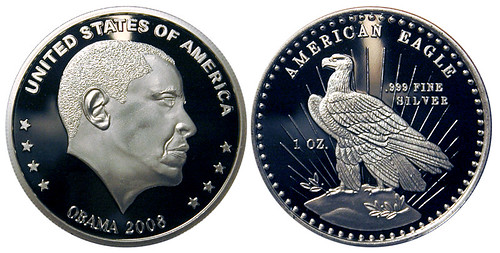
While I was not an Obama supporter it was neat to be a part of the production of the very first numismatic item associated with a presidential candidate while still in the primaries who eventually went on to win the presidency. I designed it and had it minted. Three thousand of these were struck in silver and delivered to my customer while I had 50 "Test Strikes" made in bronze for myself (with a different reverse die) that I have never offered for sale for no particular reason other than just not finding the time to market them.
To read the earlier E-Sylum article, see: KEN POTTER ON DIES AND MINTING (www.coinbooks.org/esylum_v16n19a19.html)
THE GOLDBERG'S FITZGERALD LARGE CENT SALE CATALOG
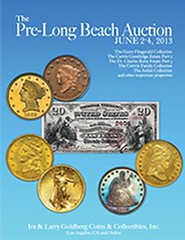 I'm writing the June 2nd Goldberg sale and the Newcomb cents that Deborah Fitzgerald put up for auction. He father (Garry) started looking for these when he knew she loved large cents and put them away for her as an investment. They consist of some of the finest and in some cases the finest 1821, 1822, 1823, 1823/2, 1824 and 1824/2 large cents known.
I'm writing the June 2nd Goldberg sale and the Newcomb cents that Deborah Fitzgerald put up for auction. He father (Garry) started looking for these when he knew she loved large cents and put them away for her as an investment. They consist of some of the finest and in some cases the finest 1821, 1822, 1823, 1823/2, 1824 and 1824/2 large cents known.
Readers should be made aware of this once in a lifetime to get these rarities and if nothing else get the catalogue which has yet to be sent out. These can be seen on the Goldberg web site. I will be flying out to see what I can "Cherry-Pick". I am honestly surprised at the starting prices on these. Hopefully I can meet up with some Early American Coppers club members while in Long Beach.

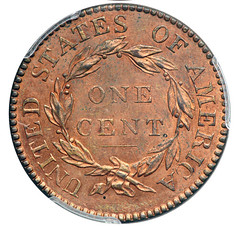
To view the catalog online, see: Sale 74: Long Beach Coin Auction June 2-5, 2013 (images.goldbergauctions.com/php/toc_auc.php?site=1&lang=1&sale=74)
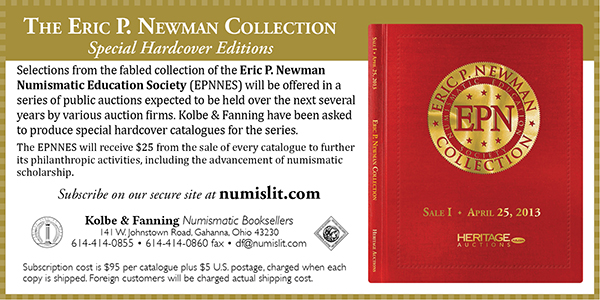
ANTIQUE GLASS GOBLET ENCAPSULATES AN 1832 DIME
An 1832 JR-5 in Glass
by Karl Lamson
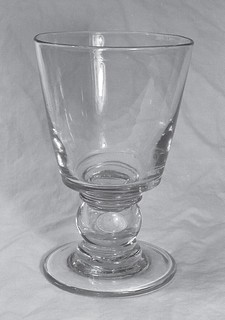 My father traveled a lot as a salesman and had a wide variety of interests. He
stopped at many antique shops, museums, places of historical significance, and
whatever interested him. On April 30, 1957 in upstate New York at “a little old
lady’s antique shop,” as he put it, he discovered a glass goblet with a coin in the
stem that intrigued him. He had never seen anything like this and bought it for the
sum of $ 9.50. Presumably, the asking price was $ 10 and he negotiated the price
down to $ 9.50. Dad rarely paid full price for anything! The coin was an 1832
United States bust dime, which is the subject of this article. For the next many years
he searched for additional glassware containing coins and was able to purchase
several more, but the goblet that he purchased in 1957 is the only one that has an
American coin in it. I inherited his collection in 1987.
My father traveled a lot as a salesman and had a wide variety of interests. He
stopped at many antique shops, museums, places of historical significance, and
whatever interested him. On April 30, 1957 in upstate New York at “a little old
lady’s antique shop,” as he put it, he discovered a glass goblet with a coin in the
stem that intrigued him. He had never seen anything like this and bought it for the
sum of $ 9.50. Presumably, the asking price was $ 10 and he negotiated the price
down to $ 9.50. Dad rarely paid full price for anything! The coin was an 1832
United States bust dime, which is the subject of this article. For the next many years
he searched for additional glassware containing coins and was able to purchase
several more, but the goblet that he purchased in 1957 is the only one that has an
American coin in it. I inherited his collection in 1987.
The goblet is exactly 6” tall, 3 7/8” rim diameter, and 3 ½” base diameter. The wall of the glass is 1/8” thick; it is a heavy, sturdy glass with a beautiful ring when it is tapped very lightly. I’ve been told that this is something that should not be done with such a valuable piece of glass, but my father very much enjoyed hearing that wonderful, clear tone when he tapped it. The glass is colorless and has no chips, dings, or scratches.
We know that glassware with an enclosed coin has been made for centuries and often is made as special, presentation pieces to commemorate an event. This is still practiced in England today; for example, goblets are made to commemorate British royal events.
In my research I discovered that the Corning Museum of Glass has a goblet that is identical to mine, except theirs is engraved. The material, form, and dimensions are identical, and the construction method is the same. The Corning example contains a U.S. 1821 bust dime in the knop and is engraved “JA 1838.”
At any rate, it is a remarkable goblet, and fortunately, it is possible to closely examine the coin that was encapsulated in the knop. It is a high grade 1832 JR-5 which exhibits numerous die cracks.
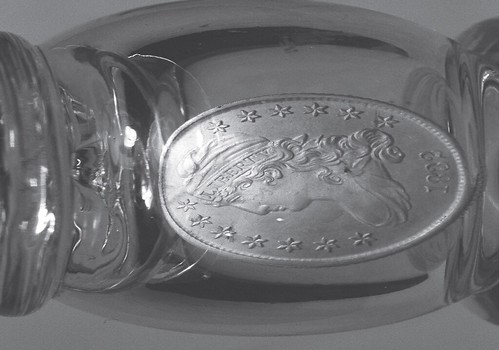
As for the grade, Russ Logan inspected this back in 2001 and said it’s not mint state but is very close. He also said that although the coin is immobile inside the knop of the goblet, he thought that originally it was free to move around inside and that at some point in history it became stuck in one position. However, I do not see any evidence of the coin making any marks on the inside of the glass, and due to the way this goblet was made, I think the coin has been gently held in the same position by the glass walls of the knop ever since the goblet was made some 180 or so years ago.
Remarkably, this really is a time capsule, and nothing has touched the surfaces of this coin except the tiny amount of air inside the knop. The surfaces are as original as we will ever see. I calculated the volume of air inside the knop as approximately one-half cubic inch. There was not much oxygen to react with the silver in this coin! Also, because the coin is immobile, the inside surface of the glass has remained scratch free, allowing clear visual inspection of the coin.
For years Dad had this goblet on display in our home, and we sometimes joked about how we should break it to get that coin out! Fortunately today it is still intact. A survey of museums shows that it is a rarity to find antique glassware containing a coin; most of them met the fate of being broken, either intentionally or accidentally. Today, this goblet is carefully stored. Even though it is not on display, I enjoy just knowing that I have it and that it’s been in my family for the last 55 years.
For more information on the John Reich Collectors Society, see: www.jrcs.org
ANOTHER LIBERTY SEATED COIN GLASS SAUCE DISH
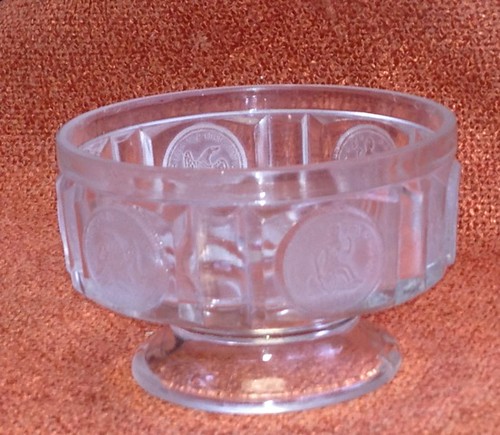
Alice writes:
I was searching the Internet for information about a dish I was going to give my grandson for graduation. It is from his great grandfather's collection. It is a clear seated liberty 1892 coin sauce dish.
I identified it from your recent article about one discovered next to a pickle jar! That one looks like it was clear on a blue back ground. I inherited mine from my father-in-law's American glass collection. How would I go about confirming its age and value? The coins protrude on the outside of the dish and the coin ridges are also observable. My father-in-law collected from 20s to 60s.
To read the earlier E-Sylum article, see: A LIBERTY SEATED QUARTER COIN GLASS SAUCE DISH (www.coinbooks.org/esylum_v15n10a17.html)
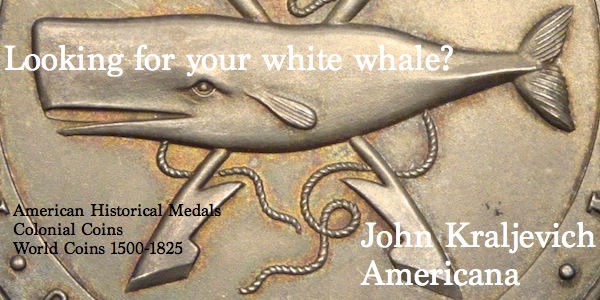
WAYNE'S NUMISMATIC DIARY: MAY 19, 2013
Tuesday evening was the May dinner meeting of my Northern Virginia numismatic social club Nummis Nova. Our host was Joe Levine and we met at an Italian restaurant named Piero's Corner. They had a nice separate area set aside for us. Most folks were already there when I arrived around 6:30. Seated around a big rectangular table were Tom Kays, Howard Daniel, Joe, Eric Schena, Gene Brandenberg, Dave Schenkman, Aaron Packard, Steve Bishop, Len Goldberg, Chris Neuzil, Roger Burdette. Only a couple seats were left. I sat next to Tom Kays and Wayne Herndon filled in between me and Roger. It was a full house.
I'd brought with me a few new copies of Fred Schwan's 2002 book on Military Payment Certificates and collected payment from Eric, Tom and Gene. Tom paid me with a stack of $2 bills which Gene promptly purchased from me. With that transaction out of the way I started reviewing the numismatic items being passed around the table.
Jon Radel had a work conflict and couldn't attend, but he'd given us a theme suggestion. He wrote:
We've not done "recycling", defined very broadly, in several years. I recall that resulting in a couple of very interesting items being shown around. If I were to be there, I could show everyone some of the odd things the Russians did to their 15 Kopek coins after they decided they were better used as telephone tokens.


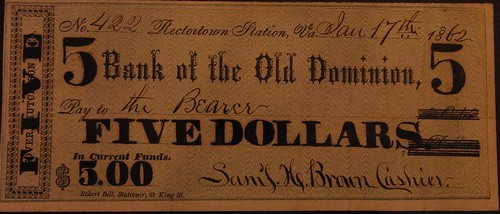
Tom Kays took photos of a few of the items being passed around. He writes:
Ford Motor Company World War I medal – National Foreign Trade Convention – Detroit, Made from (recycled bronze) of the USA Emergency Fleet, associated with the convention of 1927.
Bank of the Old Dominion at Rectortown, 1862 Five Dollar Note made from a recycled bank check. Neat!
Many more marvelous recycled coins were seen including coins with counterstamps (Mansion House, Vote the Land Free, Deanston Cotton Mill, Admit to the Model Artist’s, etc.), coins that were made into buttons and spoons, used as brine colorers, hallmark testers, admission tickets, and other forms of checks and money substitutes.
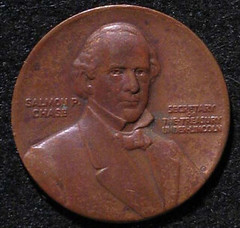

Dave Schenkman had brought along a bag of tokens and medals for us to give to kids at the local coin shows. I spent some time looking through the bag after dinner and showed a few pieces to Tom Kays. There were some better pieces in here. One that caught my eye was a bronze medal picturing Salmon P. Chase. The reverse says the piece is "A TOKEN OF A VISIT TO THE CHASE NATIONAL BANK COLLECTION OF MONEYS OF THE WORLD". I hadn't seen this one before. I found an image of one on eBay.

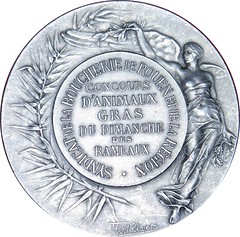
Tom Kays adds:
In follow up to the topic of animals on coins, first goat tags and then “chickens” including the enigmatic Rooster counterstamps discussed in previous E-Sylums - Gene Brandenburg still asserts those rooster counterstamps are from pre-Civil War New York; here is a curious “medal with chicken hat” (No offense intended to Frenchmen):
Art-Nouveau Silvered-Bronze medal by Louis Botee, (1852 – 1941) Officer of the Legion of Honor in 1903 – Fecit: Circa 1905. Obverse: Bust of Gallia looking right to a shining sun, wearing a winged helmet crowned with laurel and rooster. Reverse: Engraved by Adolphe Rouet, a flying victory holding a crown above a cartouche with oak leaves. “Syndicat de la Boucherie de Rouen et de la Region” meaning “Trade Union of Rouen, France in Normandy and “Concours d’animaus gras du Dimanche de Rameaux” meaning “Contest of Fat Animals during the Sunday before Easter.” Edge: Triangle mark, 2” diameter. Do any E-Sylum readers know what this contest entails?
I hadn't gotten to my bank or I would have brought some of my counterstamped coins. Aaron Packard passed around a binder with several coins and his write-ups on their history. He kindly forwarded images of them, and here are some of my favorites.
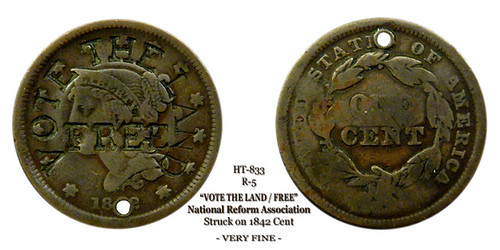
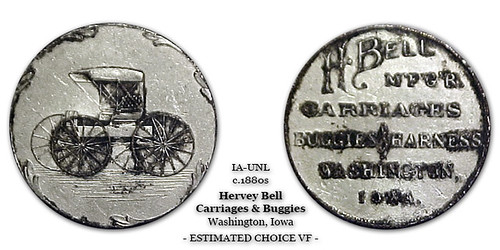
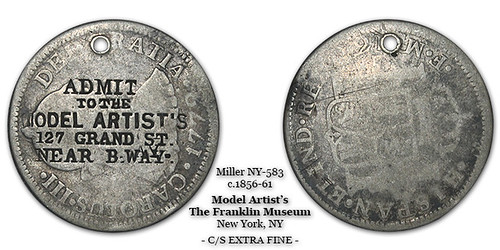
Aaron writes:
As far as I'm aware, not much (if any at all) has been published in the past about the Model Artist Token. Rulau and Brunk merely allude to their origin and purpose.
Here's an excerpt from Aaron's great web page on the "Model Artist's" Theater.
Starting in the 1850s several entertainment ventures opened in New York which made tableaux vivants their primary bill. Tableaux vivants — the forerunner of burlesque — featured actors, mostly women, posing nude or semi-nude under the guise of replicating master artworks. Theatres such as the Temple of the Muses and The Wallhalla specialized in these types of “shows.” Given the predominantly conservative social-norms of the era, nary a better gimmick for enjoining eroticism with “culture” could have been invented.
Another name for tableaux vivants, ‘Model Artist’ shows put on the air of legitimacy by having “artists” re-enact semi-nude scenes found in classical paintings. Only but the most naive person couldn’t see through the contrivance. Marquee language often hinted to customers what to expect from the shows — and the customers certainly came. Indeed, the term “Model Artists” was simply code for voyeurism, while tableaux vivants was eroticism with a slightly tamer twist.
To read the complete article, see: The “Model Artist’s” Theatre and Its Token (www.novanumismatics.com/numismatic-research/the-model-artists-peep-theatre-and-its-token/)
I didn't mingle as much as usual, but heard conversations about the Langbord 1933 Double eagles case and "what the heck is going on at ANA headquarters." Wayne Herndon reported on the Early American Coppers show in Ohio and attending his daughter's college graduation ceremony the same weekend. President Obama was the featured speaker at the Ohio State commencement. The "recycling" topic led to an unexpected discussion. I'll let Tom explain.
Tom Kays writes:
Several folks at my end of the table discussed recycling in a negative connotation whereby a lifetime collection of information, notes, and printed material obtained in numismatic research may be tossed out by heirs who don’t know or care what grandpa knew about his coin hobby. Some of us admitted that 40 years of images and databases were not properly backed-up and could be gone in a house fire.
That led to thinking about cloud storage and the need for offsite custodians of lifetime numismatic “e-collections” with orders to publish or make available to the public, any magnum opus that was near ready for release, if the author should lose it, one way or another. Some candidates for this service might include museum collections, image files of medals, tokens, Southeast Asian coins, dug coins, and who knows what all might be needing secure archiving and custodial direction someday.
As an example see Lou Jordan’s website where he shares colonial coin images and attributions from the Gore collection of Notre Dame. His is a grand example of a public service offered by numismatic academia of a collection that would otherwise be inaccessible to the casual inquirer.
Tom also brought a copy of a Hardy Boys book titled “The Melted Coins”. See an article later in this issue for more information. -Editor
THE BOOK BAZARRE
A FAKE STAR NOTE
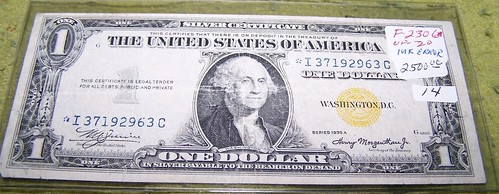
Haha. I thought this was funny. Looks like someone tried to stencil in a star (in the wrong place as well, since it takes the place of the first block letter). Then they smeared it.
To read the complete article, see: Fake Star Note (www.cointalk.com/t227883/)
HOWARD DANIEL ON FAKES IN NUMISMATICS
The item The Place of Fakes in Numismatics, by Michael Fazzari, was of great interest to me. When I read about "fakes," I have to read more to find which one of my three categories are the pieces. A counterfeit/fake is considered by me to be something made while the piece was in circulation. A replica is made after the piece was in circulation, and a fantasy is something that never existed as an authentic piece and made to mostly fool tourists and unknowledgeable collectors.
I have paid some good money for contemporary counterfeits/fakes, but I limit myself to $5 or a little over their intrinsic value for the few replicas and fantasies I need to educate other numismatists.
One of my personal tasks in Southeast Asian numismatics is to eliminate the replicas and fantasy pieces from the marketplace. I do believe contemporary counterfeits/fakes are collectible and I am always looking for them. But the replicas made after the original was circulating are not of interest to me except for a few for teaching other collectors about them. I include all of the Chinese fakes of Southeast Asian pieces in the category of replicas. The Chinese also make a few fantasy pieces but most for Southeast Asia, I have found were made by local sources to sell to tourists.
I am one of the "experts" for eBay and regularly review my countries for them and give them an opinion on them. When I discover a piece that is not accurately described on my own, I contact the seller first. About 50% are interested in knowing the truth about their piece, but the other 50% do not care and just want to sell it at a profit. You should see my emails from the latter sellers!
Michael is one of the good guys in numismatics and is doing excellent work for numismatics. If you can assist him in any way, please forward your questionable piece(s) to him.
Joe Boling adds:
On the subject of collecting fakes, the big problem with collecting them while they are fresh is that you end up supporting the market for the fakers. I have paid high prices for fakes on eBay (not being offered as fakes, of course) so that I could have them for my teaching set. When I then publicize them, I am asked why I am helping to create a demand for them. It's a tough question - I have no satisfactory reply, except that I do it to help others learn from them. Incidentally, when eBay is included in the group I am informing about them, eBay could not care less.
To read the earlier E-Sylum article, see: THE PLACE OF FAKES IN NUMISMATICS (www.coinbooks.org/esylum_v16n19a13.html)
COLLECTIBLE COIN PROTECTION ACT RE-INTRODUCED
 On May 7, 2013, Rep. Lamar Smith of Texas introduced H.R. 1849: Collectible Coin Protection Act. This bill seeks to broaden the existing Hobby Protection Act by making it unlawful to support or assist anyone who violates the act and adding trademark violations to the act.
On May 7, 2013, Rep. Lamar Smith of Texas introduced H.R. 1849: Collectible Coin Protection Act. This bill seeks to broaden the existing Hobby Protection Act by making it unlawful to support or assist anyone who violates the act and adding trademark violations to the act.
The Hobby Protection Act was enacted in 1973 and made it illegal to manufacture or import into the United States any imitation numismatic item that was not plainly and permanently marked "COPY."
Following an influx of unmarked replica and counterfeit coins manufactured in China, there were calls from the Industry Council for Tangible Assets (ICTA), professional numismatists, and collectors to provide broader enforcement powers for the act. Executives of the Professional Coin Grading Service (PCGS) had also implored Congress to take action, arranging meetings with members of Congress during which Chinese made counterfeits were shown.
In June 2012, the original Collectible Coin Protection Act was introduced by Lamar Smith. The legislation attracted 11 cosponsors and was referred to the House Committee on Energy and Commerce with no further action taken. The new bill introduced in the 113th Congress, contains similar provisions as the original bill.
As it is currently worded, the Hobby Protection Act covers the manufacture and importation of unmarked replicas for "introduction into or distribution in commerce." The Act does not make the actual sale of such items illegal. The Collectible Coin Protection Act would rectify this by adding "or the sale in commerce."
To read the complete article, see: Collectible Coin Protection Act Re-Introduced (news.coinupdate.com/collectible-coin-protection-act-re-introduced-1980/)
THE 1981 U.S. COMMEMORATIVE COIN BILL
United States commemorative coins had descended into the “dark ages” and few within the numismatic community as the decade of the 1980s began held any hope of revival.
Commemorative coin proliferation, highly questionable themes, plus private profiteering in the original series led U.S. Treasury officials to oppose all commemorative coin proposals starting in the 1950s.
The last commemorative coin in what has become known as the “Early” or “Classic” commemorative coins series — the George Washington Carver–Booker T. Washington half dollar — was struck in 1954.
In early 1981, coin collector David John was reading the “Red Book” (A Guide Book of United States Coins). He recalled recently that as he was perusing the commemorative section, he began to wonder “if we could ever do another issue” and realized that George Washington’s 250th birthday was just a year away.
Fortunately, he was well positioned to take action. He was a staff member in Rep. Doug Barnard Jr.’s Washington, D.C., office.
Barnard, a Democrat who represented Georgia’s 10th congressional district, had just been re-elected to his third term in Congress.
Today, John vividly remembers approaching Rep. Barnard to introduce legislation to authorize a new commemorative coin honoring the anniversary of Washington’s birth.
“The first time that I brought it to Mr. Barnard, he was not interested, but I tried again and he readily agreed this time so we had the bill drafted.”
Rep. Barnard introduced the bill (H.R. 2524) on March 16, 1981.
Thirty-two years ago, David John’s pursuit of an idea led U.S. commemorative coins out of the “dark ages” and launched the Modern Commemorative era.
He still collects coins, and specializes in medieval English coins.
To read the complete article, see: From the start (www.coinworld.com/Articles/ViewArticle/from-the-start)

INTERNATIONAL TRAVEL WITH PRECIOUS METALS
Imagine you are docilely going through the long security line at John F. Kennedy International Airport, headed for your overnight flight to London Heathrow. As your carry-on bag goes through the X-ray, a burly TSA agent is called over to confer with the machine operator. He then looks at you and says: "Please come with me, sir."
As you are led to a small cubicle, you nervously try to think of what you might have done wrong. While you open your bag as instructed, the stern-faced TSA agent points to a small package and demands to know what it contains. Inside are antique, collectible gold coins that you intend to sell to the same British dealer from whom you bought them years ago, but now they are worth much more.
Now the agent says: "I'm sorry, sir, I will have to confiscate them, but I will give you a receipt. You have the right to file an appeal."
You stand there dumbfounded, the whole purpose of your journey destroyed.
Serious problems can arise when gold or silver coins (or any precious metals) are transported personally out of the U.S. to other countries by auto, airplane, boat or public transportation - or the reverse, when entering the U.S.
In May 2010, the Houston reported that U.S. Immigration and Customs (ICE) agents and Border Protection officers at Houston's George Bush Intercontinental Airport confiscated more than $250,000 in cash and almost $160,000 in gold and silver in 14 separate seizures from individual travelers during that one month alone.
If you must personally carry coins, my advice is to contact the nearest office of the U.S. Customs and Border Protection Agency, well ahead of travel, and explain what you propose to do and ask them how you can conform to the law. You should ask for and receive a written response so that you can show it if questioned by ICE agents. Also ask Customs if you need to notify them of your date and departure flight as a precaution against the very real possibility that a local Customs agent at the airport may not know the rules that cover this situation.
You will need to complete and bring with you a Census Bureau Form 7525-V, Shipper's Export Declaration. This form is required for exported commodities with a value exceeding $2,500. At current silver and gold prices, many coins would exceed this reporting threshold. Failure to file this declaration can result in seizure. The consequences for stating incorrect information are severe, including confiscation. They may also result in a fine of up to $10,000 and/or imprisonment.
To read the complete article, see: Traveling With Precious Metals (www.internationalman.com/78-global-perspectives/808-traveling-with-precious-metals)
Kavan adds:
This news item from 2011 Oct describes a real incident of a tourist with US$ Million. The only time I was stopped was in 2003 when I was returning to USA, transiting Bahrain with few modern Gold and Silver Sri Lankan commemorative coins. I had neatly packed the coins in their plastic capsules within a long transparent tube in my hand luggage. That probably caught the attention of the security X-ray. Luckily I had my export permit from the Central Bank of Sri Lanka, and they accepted them as legal tender, and not bullion.
The couple was approaching the immigration counter at the BIA after the airline check-in, when they were hailed by Customs officials at 10.30 pm on Sunday, October 16.
The old woman and the middle aged person who claimed to be her son, inquired as to what the problem was.
The Customs had been alerted and the officers informed they wanted to check the couple’s baggage. The two passengers appeared unrattled and despite the confrontation did not react like ‘offenders’.
They were taken to the Customs desk in the far corner where their bags were placed before them and opened. What was inside made headlines in the local newspapers the next day.
In the bags there were stacks of gold in many forms; coins, jewellery and bars, and quite a significant amount of foreign currency worth over Rs. 120 million in total. They were not concealed but out in the open neatly packed to see by anyone who happened to open the bags. The two passengers who were to board a plane bound for Kuala Lumpur that night insisted that it was their own wealth, the wealth that his father, who passed away recently, had left behind. He and his mother had collected all the wealth and sold their property and were travelling the world to find a peaceful place to settle down.
This was the story the Customs was told.
The duo, 73-year-old woman and the 43-year-old male, were Korean born US citizens. Being repeatedly questioned about his vocation the man claimed although reluctantly, he was a writer of philosophy. “I have no issue in accepting their story but there is no proof that they brought the valuables with them when they arrived in Sri Lanka from India on October 12,” Customs Deputy Director M.R. Rajmohan who heads the inquiry told Sunday Observer.
To read the complete article, see: Smuggling ring or genuine travellers? (www.sundayobserver.lk/2011/10/23/sec04.asp)
AMAZON COINS
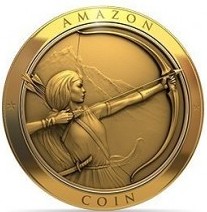 Straight from Amazon's press room comes the news that Amazon has officially launched Amazon Coins, which the company excitingly claims are "a great way for customers to save money when they buy apps, games and in-app items" for Kindle Fire users. To help everyone start using Amazon Coins, Amazon has deposited 500 of them into the accounts of all existing and new Kindle Fire users in the US.
Straight from Amazon's press room comes the news that Amazon has officially launched Amazon Coins, which the company excitingly claims are "a great way for customers to save money when they buy apps, games and in-app items" for Kindle Fire users. To help everyone start using Amazon Coins, Amazon has deposited 500 of them into the accounts of all existing and new Kindle Fire users in the US.
Amazon Coins were initially announced back in February, with the company saying they're primarily designed to benefit developers and consumers. "For customers, Amazon Coins is an easy way to purchase apps and in-app items on Kindle Fire, and for developers it’s another opportunity to drive traffic, downloads and increased monetization," proclaims this morning's press release.
Ecosystem-specific virtual points systems like Microsoft Points and Amazon Coins have some marginal benefits to consumers and developers, but the real winner is always going to be the issuer—Amazon isn't doing this out of the goodness of its publicly traded heart. Shortly after Amazon Coins were announced in February, The Verge put up a very cogent analysis of the good and bad points behind the system, and the folks stuck using these systems—the customers—are the ones receiving the short end of the stick.
The biggest problem is the inevitable misalignment between "coins" purchased and "coins" used. This is a problem with Microsoft Points, or indeed any points system. Want to buy an app or an in-app purchase for $1? Too bad, because right now, the smallest number of coins you can buy is 500, which will cost you $4.80. You now have $3.80 locked up in Amazon Coins, and there's no way to turn that back into real money.
Now your $3.80 is essentially "spent," and you've got a pretty heavy psychological incentive to get rid of it—you don't want to waste it, do you? As with every other points-based system, it's difficult to "zero" the account; what you want to spend your points on will rarely line up with the number of points you can acquire.
From Amazon's perspective this is fabulous. Every unused Amazon Coin in your account is a little interest-free loan you've been kind enough to extend to Amazon.
To read the complete article, see: Amazon’s new “virtual currency” of dubious benefit to customers (arstechnica.com/business/2013/05/amazons-new-virtual-currency-of-dubious-benefit-to-customers/)
Archives International Auctions, Part XV
Archives International Auctions, Part XVJune 4th, 2013
Worldwide Banknotes, Coins, Scripophily & Autographs
10:00 am Local Time (lots 1-903)
U.S. Coins, Banknotes & Security Printing Ephemera
No earlier than 5:00 pm (lots 904-1092)

Mercantile Bank of India, 1941 Issue
Rare U.S. & Worldwide Banknotes, Coins Scripophily and Security Printing Ephemera Including Additional Selections from the Hamtramck Collection, another offering from the American Bank Note Commemoratives Inventory as well as Properties of Banknotes, Coins and Scripophily from various consignors.
and Security Printing Ephemera Including Additional Selections from the Hamtramck Collection; The Somerset Collection as well as distinguished
Properties of Banknotes, Coins and Scripophily from various consignors.
June 4th, 2013 at our offices in Fort Lee, New Jersey
Included will be over 1,000 lots of Rare Worldwide Banknotes,
Coins, Scripophily and security printing ephemera.
Please view our website for auction updates
1580 Lemoine Avenue, Suite #7
Fort Lee, NJ 07024
Phone: 201-944-4800
Email: info@archivesinternational.com
WWW.ARCHIVESINTERNATIONAL.COM
SOTHEBY'S TO SELL BRITISH POSTAL MUSEUM DUPLICATES
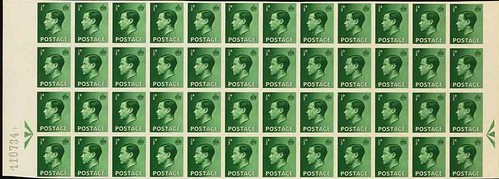
The auction will comprise material duplicate to the archive collection, with proceeds to benefit the new home of The British Postal Museum & Archive, which will be situated at Calthorpe House on London’s Mount Pleasant site and is scheduled to open in early 2016. In the July sale, collectors will have a choice of selected issues from the reigns of King George V (Seahorse issues), King Edward VIII and King George VI (definitive issues). The auction comprises 191 lots and is estimated to bring in excess of £5 million.
Commenting on the collection of stamps to be offered, Richard Ashton, Sotheby’s Worldwide Philatelic Consultant, said: “This selection of material from The British Postal Museum & Archive includes numerous items that are of the utmost rarity. Now in my 50th year as a professional philatelist, I have never seen such an important sale of its type. Many are the only examples of their kind ever to come on to the market. Quite aside from their rarity, these extraordinary stamps are also of great beauty – engraved to the highest standard by leading masters of the day. Collectors will never again be presented with such a unique opportunity.”
KING GEORGE V – The “Seahorse” Issues, 1915 to 1934 (Lots 1-12)
The "Seahorse" Issues, 1915 to 1934 are considered to be the finest stamps ever produced by Great Britain. The balance of design and the superb printing techniques employed converged to produce a series that is immensely popular with collectors. Designed by Bertram Mackennal with lettering by George W. Eve, the master die was engraved by J.A.C. Harrison. The "Seahorse" high face value stamps were in use for twenty-six years and involved four contractors. Variations in the paper, a plethora of shades and many different printing plates shaped their development during this time. The printers devoted much attention to the printing plates and this resulted in a host of re-entries, which are highly prized.
KING EDWARD VIII – Definitive Issues (Lots 13-40)
King Edward VIII ascended the throne on 20th January 1936. A few days later, the Post Office took the first steps in preparing designs for the postage stamps of the new reign. The designer of the iconic issue has been acknowledged as Hubert John Brown and a very poignant story regarding the design emerged in the years that followed. H.J. Brown recalled how, when sitting an examination at the age of eighteen in 1936, his thoughts strayed and he began to wonder what sort of stamps there should be for the new reign. He sketched a rough design and submitted it to the Postmaster General.
A letter of acknowledgement was received by return with the comment: “I should perhaps mention, however, that the design is usually chosen from the competitive designs of distinguished artists.” The King rejected all the designs for the stamps save one which was, in fact, the design submitted by Mr Brown. Though certain adjustments were made, the issued stamp was essentially the work of Hubert Brown. The establishment was thrown into crisis with the King’s abdication and only following extensive publicity in the press was a begrudging acknowledgment prised from the Post Office confirming the identity of the young designer of the new stamps. Sotheby’s met with Hubert Brown in 1998 and his original sketches and archive were offered by the company in July 1999. Mr Brown passed away in December 1998 and is fondly regarded as a man who broke the staid mould of British stamp design.
Four values in the design were issued and Sotheby’s sale includes a single set, sets in pairs and blocks of four, and a set in blocks of six which have the printing Cylinder number. The star lot in this section is a set of four Registration blocks of 48, estimated at £100,000-120,000 (lot 18). Also on offer are blocks from the special Booklet panes of six in various forms, a similar range of Coil stamps, produced for use in vending machines, and the Postage Due issues from 1936 to 1937. Lot 40 comprises a unique collection of King Edward VIII issues, essentially ‘one-of-each’ from this reign, offered with a tempting estimate of £20,000-25,000.
To read the complete article, see: Sotheby's unveils the contents of Sale of Duplicate Stamps from The British Postal Museum & Archive in London (artdaily.com/index.asp?int_sec=2&int_new=62597#.UZVzjLWNqXg)
QUERY: STORIES OF MISATTRIBUTED COINS SOUGHT
Tom writes:
I have a Hardy Boys book “The Melted Coins” in which fictional characters were shown a Pine Tree Shilling dated 1681. This may well be about when the coin was made, but Pine Tree Shillings were back dated to 1652 (and some fractions to 1662). This is one example of an author’s inaccurate description of a real coin in a fictional story, with no harm done. The challenge for E-Sylum readers is to tell of other inaccurate coin descriptions (real or fictional) that lead to a good story.
For example, the Walton 1913 Liberty Head nickel was held in a holder for an altered date 1913 counterfeit for 40 years and how that misattribution and rediscovery captured the imagination of numismatic convention-goers in Baltimore in 2003. There must be dozens of pretty good stories arising from inaccurate descriptions of coins. Perhaps a numismatist features as the hero in your (mostly) true tale, or perhaps the villain who misattributed the coin in the first place. Do tell - keeping artistic license to a minimum.
THE BOOK BAZARRE
BALDWIN’S INAUGURAL MILITARY SALE
2012 saw three major players in the UK fine art and collectibles industry (Apex, Baldwin’s and Dreweatts & Bloomsbury Auctions) combine to create the UK’s newest ‘top 5’ generalist auctioneer under the banner of Noble Investments (UK) PLC. 2013 will see Baldwin’s and Dreweatts holding their first joint auction of Orders, Decorations, Medals and Militaria on the 5th June this year at Dreweatts London, 24 Maddox Street.
Noble Investments (UK) PLC Managing Director, Ian Goldbart, commented: ‘The collective efforts of, and expertise within Baldwin’s and Dreweatts & Bloomsbury Auctions will enable us to provide a much broader presence in this fascinating market sector. We are delighted to be holding this inaugural joint auction and look forward to offering our vendors and buyers an enlarged platform through which to buy and sell a much broader range of collectibles.’
This first auction will contain 217 lots including the highlight of the sale, lot 6, the Superb and Extremely Rare WWII Pathfinder’s CGM & DFM Group of 5 awarded to Warrant Officer S J H Andrew, No 35 Squadron, No 8 (Pathfinder Force) Group, Royal Air Force Volunteer Reserve.
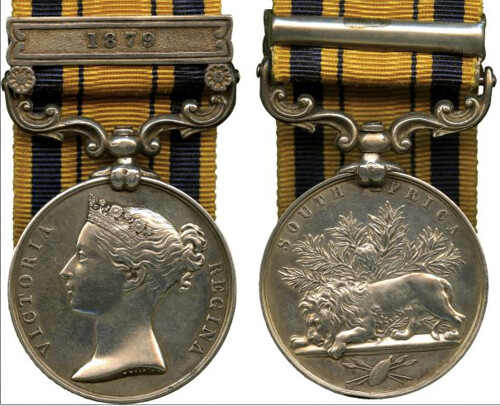
Lot 37: A Rare and Emotive South Africa 1879 Casualty Medal awarded to Trooper Francis 'Louis' Secretan, Natal Mounted Police, killed in action at the Battle of Isandhlwana during the final retreat along the Fugitives' Trail towards the Buffalo River, the location of his death confirmed as reported by his brother Archer Jeston Secretan in The Standard, March 25th, 1879, comprising: South Africa Medal, 1877-79, single clasp, 1879 (Tr F. Secretan. Natal Md Police.); officially engraved in large upright capitals, court mounted for display. Light and attractive tone, small lower reverse edge bruise and tiny nick, otherwise good very fine, and extremely rare when found with such detailed biographical and historical information.
For more information on the sale, see: www.baldwin.co.uk
VIKING COIN HOARD UNCOVERED IN DENMARK
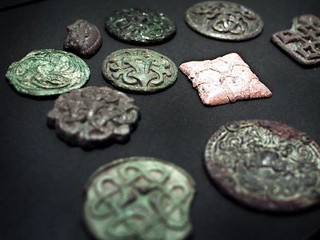 Thousand-year-old coins from the age of Harald Bluetooth were found in a field by three young men using metal detectors
Thousand-year-old coins from the age of Harald Bluetooth were found in a field by three young men using metal detectors
A trove of 200 Viking coins that was uncovered in a field in North Jutland is considered to be one of the most significant archaeological discovery in decades.
A team of three amateur archaeologists, the youngest just 16 years old, found the silver coins using metal detectors last September in a field near the northern Jutland town of Strandby.
The coins date back to around the year 990 under the rein of Harald Bluetooth and include rare ‘korsmønter’, crossed coins, that are considered to be Denmark's first national coin.
“Korsmønter aren’t something that are found every day and the enormous quantity is also exceptional,” Sidsel Wåhlin from Vendsyssel Historisk Museum told Radio24syv. “We have never uncovered such a large find from the period in northern Jutland.”
The coins will first be exhibited at Vendsyssel Historisk Museum before being transported to the National Museum in Copenhagen which will determine whether the three men, two brothers and their friend, are entitled to a reward.
You can read more about their discovery on their website: www.bricksite.com/stokke/historien-bag-fundet
To read the complete article, see: Rare trove of Viking coins discovered by amateurs (cphpost.dk/news/national/rare-trove-viking-coins-discovered-amateurs)
FEATURED WEB PAGE: COIN SPOONS
This week's Featured Web Page is the coin section of the SpoonPlanet.com site, suggested by Tom Kays. Thanks!Coins, silver and spoons have a long intertwined history. For several hundred years silver objects were simply another form of wealth. A person who had amassed more silver coins than they needed, took the coins to a silversmith who melted them down and made a usable object out of them. If economic hardship ensued, the reverse procedure was used and the silver objects were returned to coinage form.
It was felt that a silver object offered more protection against theft since it was more easily recognizable than a coin. Also it served a useful purpose whereas a coin could only be hidden until it was needed. Furthermore, it was possible to display ones "wealth" without simply putting a pile of coins in the cupboard. The value of the workmanship was considered secondary to the value of the metal.
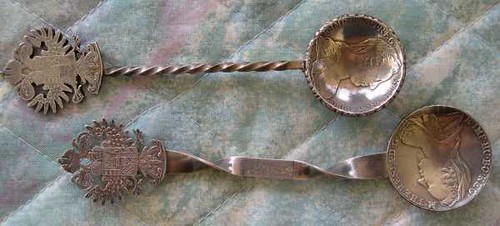
www.spoonplanet.com/coin.html
